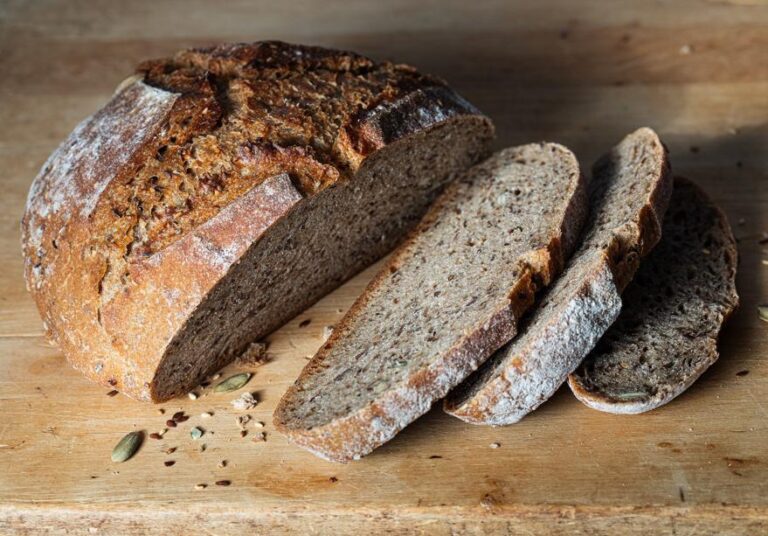This is the first of two bread recipes for winter baking. Neither are kneaded, but rather made with a stretch-and-fold motion right in the bowl. The second recipe will run in this space on Feb 5.
My childhood memories of winter days at my grandmother’s, eating dense, hearty rye bread slathered with butter alongside bowls of soup, inspired a personal quest to re-create a similar loaf. She would not have made the bread herself, but now after many trials, I’m baking it in my own kitchen. So can you. This is a slow-rise dough made with rye flour, whole-wheat flour, bread flour, caraway seeds, flax seeds, pumpkin seeds, and sesame seeds.
After you mix the dough with a wooden spoon, you give it a slow rise at room temperature (overnight is easiest). It’s a relatively wet dough, which enhances flavor and simultaneously enables gluten strands to lengthen and align naturally over several hours. Those developed gluten strands are what allow bread to rise in the oven without collapsing. After the long rise, you’ll perform a series of three stretch-and-fold steps with 20-minute rests in between to help relax the dough.
The trickiest part is mixing the dough initially with the correct flour-to-liquid ratio. When you go to measure flour, a measuring cup is less precise than a scale, since flour compacts easily in a cup. You’ll find both cup and weight measurements here for the flours and water. If you do use a cup for the flours, fluff them before spooning them into a dry measuring cup (not a glass cup for liquids) and level the excess with the swipe of a knife. Once mixed, adjust the liquid according to how the dough feels. To bake the bread, preheat a cast-iron Dutch oven and lid in the oven. The dough will be on a piece of parchment. Lift it, still on the paper, and ease it into the hot pot. While the dough bakes, it releases moisture, creating a mini steam oven in the pot and giving the loaf a deep golden, crispy crust. Near the end of baking, remove the lid.
If you’re new to homemade bread, just take it one step at a time. You’ll be successful and get the hang of it. You’ll also get practice in hygge (pronounced hue-gah), the Danish concept for all things cozy. That’s what this bread is all about. SALLY PASLEY VARGAS
Makes 1 large loaf
1¼ cups (133 g) rye flour
1 cup (113 g) whole-wheat flour
1⅔ cups (200 g) bread flour
½ teaspoon instant yeast
1 teaspoon salt
Extra bread flour (for sprinkling on the cloth)
2 tablespoons caraway seeds
2 tablespoons flax seeds
2 tablespoons pumpkin seeds
2 tablespoons sesame seeds
1½ cups (350 g) water
1 teaspoon olive oil
1. In a large bowl with a wooden spoon or sturdy rubber spatula, blend the rye flour, whole-wheat flour, bread flour, yeast, and salt together until thoroughly combined.
2. Make a well in the center and add the water. Stir with the spoon or spatula until the dough is well mixed and no traces of flour remain. If there is flour in the bottom of the bowl, hold the bowl with one hand and use the other hand to squeeze the dough until it comes together. It should feel sticky, but still smooth and manageable; it will become more elastic after stretching. If it feels stiff or dry, trickle a few more tablespoons of water into the bowl and work it in with your hand. It is better to have a dough that is too sticky than one that is too stiff.
3. Use the spatula or a plastic dough scraper to scrape down the sides of the bowl. Push the dough together to form a loose ball. Drizzle the top of the dough with the olive oil. Pat it around the surface of the dough with your fingers. Cover the bowl with plastic wrap. Set aside at room temperature to rest for 8 to 12 hours (overnight is easiest).
4. Meanwhile, fill a small bowl with water. Dust a linen or another smooth dish towel (not terrycloth) with bread flour. Place the cloth, flour side up, in a bowl that is about 9 inches in diameter.
5. Leave the dough in its mixing bowl. At this point the ball of dough should have at least doubled in size. Sprinkle it with the caraway, flax, pumpkin, and sesame seeds.
6. Reach under one side of the dough in the bowl, pick it up, stretch it, and fold it over the top of the dough. If the dough sticks to your fingers, dip them in the water. Rotate the bowl 90 degrees and repeat the stretch and fold. Do this 2 more times, turning the bowl each time, for a total of 4 stretch-and-folds, going all around the dough ball. Cover the bowl with plastic wrap. Let it rest for 20 minutes.
7. Repeat this stretch-and-fold motion 2 more times. In the end, you’ll have completed 3 sets of stretch-and-folds and 3 rests.
8. Use the spatula or dough scraper to scrape the dough onto the counter in one lump. Place your fingers underneath the dough edge that is farthest from you. Pick it up and stretch it ⅔ of the way toward you. Pick up the bottom edge of the dough and stretch it ⅔ of the way away from you. Pick up each side of the dough and stretch it toward the center. Pinch the dough in the center to seal the edges. If the dough is sticky, wet your hands.
9. Turn the dough over so the smooth side is on top. Cup your hands around the dough and shape it into a smooth round. Flip the dough upside down into the bowl. If the dough sticks to the counter, slide a bench scraper under it. (You will ultimately turn it over again after it has risen so the smooth side is on top.) Let it rise at room temperature for 1½ to 2 hours, longer if the room is cold, until the dough has doubled in size.
10. About 30 minutes before you are ready to bake, adjust an oven rack to the bottom position. Place a 5- to 7-quart cast-iron Dutch oven or enameled cast-iron Dutch oven and the lid in the oven. Set the oven at 450 degrees. Have on hand a 15-inch piece of parchment paper.
11. When the dough has risen, place the parchment paper over it. Support the top with one hand and use the other hand to flip the bowl over carefully and set the dough on the parchment paper on the counter. Use a serrated knife to make a large cross, about ½ inch deep, on top of the round.
12. Remove the hot pot from the oven and lift off the lid. Holding the edges of the parchment paper, drop the round, on the parchment, into the pan. Use an offset or small metal spatula to press the parchment flat into the sides of the pan. Cover with the pot lid.
13. Bake the round for 30 minutes. Remove the lid. Continue baking for 10 minutes, or until the loaf is a deep golden brown. (Total baking time is 40 minutes.)
14. Remove the pot from the oven. Slide a large metal spatula under the loaf. Transfer it (without the parchment paper) to a wire rack to cool completely before slicing. Sally Pasley Vargas


